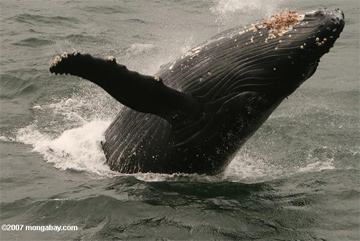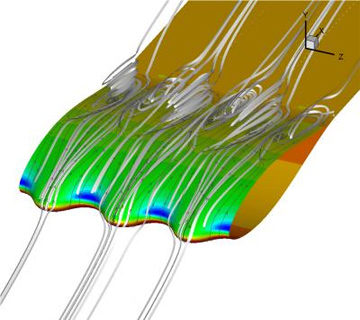Whale biomimicry inspires better wind turbines
Whale biomimicry inspires better wind turbines
mongabay.com
July 7, 2008
By studying and mimicking the characteristics of the flippers, fins and tails of whales and dolphins, engineers have devised more a efficient way to generate wind power, reports a researcher presenting at the Society for Experimental Biology’s Annual Meeting in Marseille, France.
Dr Frank Fish of West Chester University says that the shape of whale flippers has inspired the creation of a completely novel design for wind turbine blades.
“Engineers have previously tried to ensure steady flow patterns on rigid and simple lifting surfaces, such as wings. The lesson from biomimicry is that unsteady flow and complex shapes can increase lift, reduce drag and delay ‘stall’, a dramatic and abrupt loss of lift, beyond what existing engineered systems can accomplish,” Fish said. “There are even possibilities that this technology could be applied to aeronautical designs such as helicopter blades in the future.”
 Humpback whale in Alaska
|
The research, which was funded by the US National Science Foundation and the US Office of Naval Research, looked specifically at the vortices formed in the wake of the marine mammals.
“In the case of the humpback whale, vortices formed from tubercles (bumps) on the front edge of flippers help to generate more lift without the occurrence of stall, as well as enhancing manoeuvrability and agility,” he explained. “In the case of the tails of dolphins, vortices are formed at the end of the up and down strokes. These vortices are involved in the production of a jet in the wake of the dolphin that produces high thrust. By regulating the production of the vortices, the dolphin can maximize its efficiency while swimming.”
Fish, F. E., Howle, L. E. and Murray, M. M. 2008. Hydrodynamic flow control in marine mammals; Integrative and Comparative Biology 211: 1859-1867.
Shark biomimicry produces renewable energy system
(11/1/2006) An Australian firm has developed a renewable tidal energy conversion system based on the highly efficient fin structure of shark, tuna, and mackerel. BioPower Systems Pty Ltd., a renewable energy systems company based in Eveleigh, New South Wales, says that its bioSTREAM technology for converting tidal and marine current energy into electricity is modeled on biological species, such as shark and tuna, that use Thunniform-mode swimming propulsion.
Biomimetics, technology that mimcs nature
(7/11/2005) Engineers, scientists, and business people alike are increasingly turning toward nature for design inspiration. The field of biomimetics, the application of methods and systems found in nature to engineering and technology, has spawned a number of innovations far superior to anything the human mind alone could have devised. The reason is simple. Nature, through billions of years of trial and error, has produced effective solutions to innumerable complicated real-world problems. The rigorous competition of natural selection means waste and efficiency is not tolerated in natural systems, unlike many of the technologies devised by humans.
Design of new Mercedes-Benz bionic car inspired by fish body shape
(7/10/2005) DaimlerChrysler is using a new concept vehicle to examine the great potential of bionics for automobile development, and has achieved outstanding results for fuel consumption and emissions with a combination of pioneering diesel engine technology and innovative emission control methods. The Mercedes-Benz bionic car study will have its world premiere at this year’s DaimlerChrysler Innovation Symposium in Washington.








